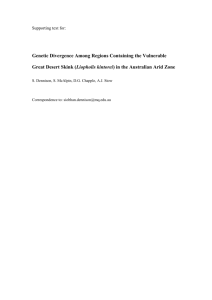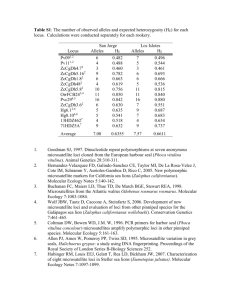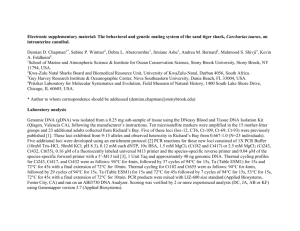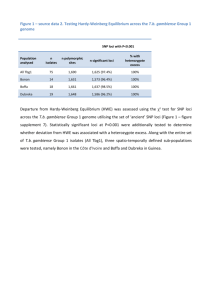Characterization of polymorphic microsatellites in the logrunner, (Aves: Orthonychidae)
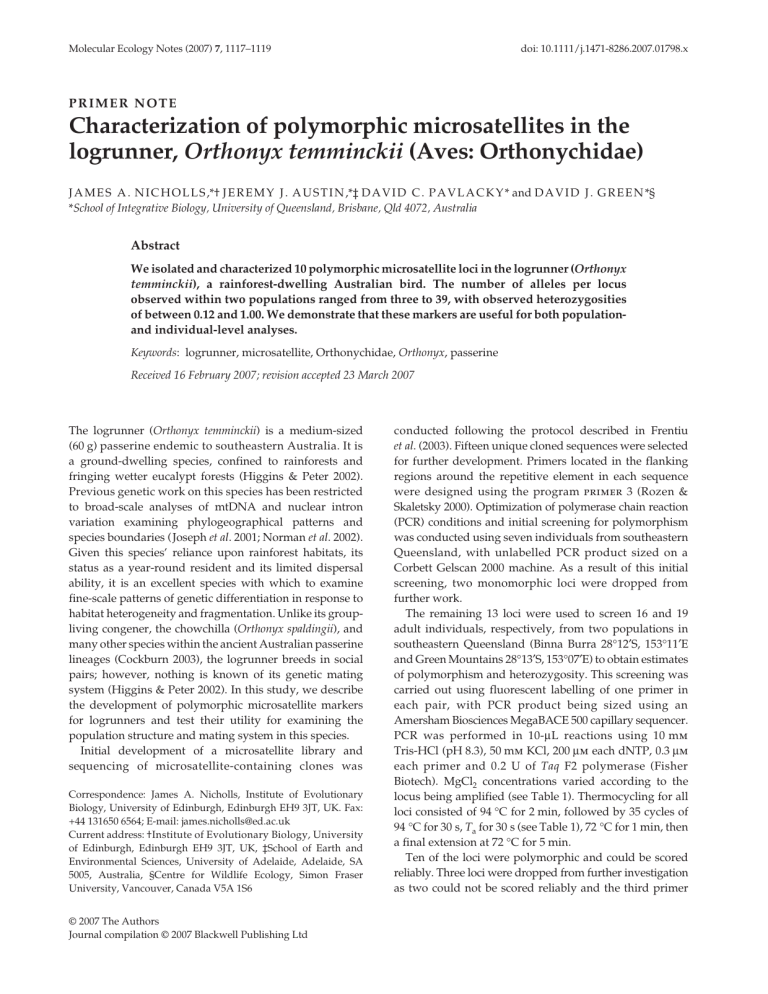
Molecular Ecology Notes (2007) 7 , 1117–1119 doi: 10.1111/j.1471-8286.2007.01798.x
Blackwell Publishing Ltd P R I M E R N O T E
Characterization of polymorphic microsatellites in the logrunner, Orthonyx temminckii (Aves: Orthonychidae)
J A M E S A . N I C H O L L S ,*† J E R E M Y J . A U S T I N ,*‡ D A V I D C . P A V L A C K Y * and D A V I D J . G R E E N * §
* School of Integrative Biology, University of Queensland, Brisbane, Qld 4072, Australia
Abstract
We isolated and characterized 10 polymorphic microsatellite loci in the logrunner ( Orthonyx temminckii ), a rainforest-dwelling Australian bird. The number of alleles per locus observed within two populations ranged from three to 39, with observed heterozygosities of between 0.12 and 1.00. We demonstrate that these markers are useful for both populationand individual-level analyses.
Keywords : logrunner, microsatellite, Orthonychidae, Orthonyx , passerine
Received 16 February 2007; revision accepted 23 March 2007
The logrunner ( Orthonyx temminckii ) is a medium-sized
(60 g) passerine endemic to southeastern Australia. It is a ground-dwelling species, confined to rainforests and fringing wetter eucalypt forests (Higgins & Peter 2002).
Previous genetic work on this species has been restricted to broad-scale analyses of mtDNA and nuclear intron variation examining phylogeographical patterns and species boundaries (Joseph et al . 2001; Norman et al . 2002).
Given this species’ reliance upon rainforest habitats, its status as a year-round resident and its limited dispersal ability, it is an excellent species with which to examine fine-scale patterns of genetic differentiation in response to habitat heterogeneity and fragmentation. Unlike its groupliving congener, the chowchilla ( Orthonyx spaldingii ), and many other species within the ancient Australian passerine lineages (Cockburn 2003), the logrunner breeds in social pairs; however, nothing is known of its genetic mating system (Higgins & Peter 2002). In this study, we describe the development of polymorphic microsatellite markers for logrunners and test their utility for examining the population structure and mating system in this species.
Initial development of a microsatellite library and sequencing of microsatellite-containing clones was
Correspondence: James A. Nicholls, Institute of Evolutionary
Biology, University of Edinburgh, Edinburgh EH9 3JT, UK. Fax:
+44 131650 6564; E-mail: james.nicholls@ed.ac.uk
Current address: †Institute of Evolutionary Biology, University of Edinburgh, Edinburgh EH9 3JT, UK, ‡School of Earth and
Environmental Sciences, University of Adelaide, Adelaide, SA
5005, Australia, §Centre for Wildlife Ecology, Simon Fraser
University, Vancouver, Canada V5A 1S6
© 2007 The Authors
Journal compilation © 2007 Blackwell Publishing Ltd conducted following the protocol described in Frentiu et al . (2003). Fifteen unique cloned sequences were selected for further development. Primers located in the flanking regions around the repetitive element in each sequence were designed using the program primer 3 (Rozen &
Skaletsky 2000). Optimization of polymerase chain reaction
(PCR) conditions and initial screening for polymorphism was conducted using seven individuals from southeastern
Queensland, with unlabelled PCR product sized on a
Corbett Gelscan 2000 machine. As a result of this initial screening, two monomorphic loci were dropped from further work.
The remaining 13 loci were used to screen 16 and 19 adult individuals, respectively, from two populations in southeastern Queensland (Binna Burra 28 and Green Mountains 28 ° 13 ′ S, 153 ° 07
° 12 ′ S, 153 ° 11 ′ E
′ E) to obtain estimates of polymorphism and heterozygosity. This screening was carried out using fluorescent labelling of one primer in each pair, with PCR product being sized using an
Amersham Biosciences MegaBACE 500 capillary sequencer.
PCR was performed in 10µ L reactions using 10 m m
Tris-HCl (pH 8.3), 50 m m KCl, 200 µ m each dNTP, 0.3 µ m each primer and 0.2 U of Taq F2 polymerase (Fisher
Biotech). MgCl
2
concentrations varied according to the locus being amplified (see Table 1). Thermocycling for all loci consisted of 94 ° C for 2 min, followed by 35 cycles of
94 ° C for 30 s, T a
for 30 s (see Table 1), 72 ° C for 1 min, then a final extension at 72 ° C for 5 min.
Ten of the loci were polymorphic and could be scored reliably. Three loci were dropped from further investigation as two could not be scored reliably and the third primer
1118 P R I M E R N O T E
Table 1 Details of 10 polymorphic microsatellite loci in Orthonyx temminckii including: primer sequence; repeat unit; annealing temperature
( T a
) and MgCl
2
concentration for PCR amplification; the number of alleles, size range, observed heterozygosity ( H
O
) and expected heterozygosity ( H
E
) observed across two SE Queensland populations; and GenBank Accession no. for the cloned allele. An asterisk after the primer sequence indicates the fluorescently labelled primer
Locus
OT2
OT3
OT4
OT7
OT8
OT10
OT11
OT12
OT13
OT15
Primer sequences (5 ′ –3 ′ )
TAGGATGGAAAGGCAGTTGG
CATGCAAGGCAGTTCAGGTA *
GCTGCTCAGACTGTGGAACA *
GTGGGTCCTGCAAGTTGATT
CAGGCTGAAATGCTGAGAAA *
ACTGGTGAAACCCTTGATGC
ACTCGAGGCAGTGCTGAAAT *
GGGGCATTCAGAAGACTGAG
ACTACAGAAATGCAAAGAAACA *
GGTGCCATTACTTGCCAGAC
AAGCACGCTGTGACTCTGTG *
CAAATATGTTTTCCAATCAGAG
AGTGACACCACCAGCAGTCA *
CTGAAGTTCTGCTTTGACCTGA
GGGGTAAAGCTGTGCCTTAAT *
GCAAGCTCCAGAGGCACTTA
CCTACCACACGGTTATATTCCT *
GCAAGAAGTCAAGGCTCTGG
CAGTGGGATTGGGAAGAGAA *
TGGCAAGCAAAACAAGGAAT
Repeat unit
AG
GA
CCT
AAGG
AAAAG
AAGG
AGG
TCCC
TATC
AC
(
T
° a
64
58
60
64
60
60
62
60
64
58
C)
MgCl
2
(m m )
1.5
1
1
1.5
1.5
1.25
1
1
1.5
1
Number of alleles
4
15
7
17
39
13
3
3
24
3
Size range
(bp)
246–256
81–145
146–170
186–316
280–640
196–290
140–152
123–131
208–281
137–143
H
O
0.63
0.80
0.69
0.60
1.00
0.59
0.27
0.12
0.71
0.21
H
E
0.65
0.89
0.80
0.93
0.98
0.79
0.29
0.11
0.95
0.24
GenBank no.
EF433779
EF433780
EF433781
EF433782
EF433783
EF433784
EF433785
EF433786
EF433787
EF433788 pair concurrently amplified two duplicate loci. The remaining
10 loci had between three and 39 alleles per locus. Linkage disequilibrium and Hardy–Weinberg equilibrium were examined for each locus in each population using the program genepop version 3.4 (Raymond & Rousset 1995).
None of the loci were linked (all P > 0.05). Three loci (OT7,
OT10 and OT13) were out of Hardy–Weinberg equilibrium in the Green Mountains population (all P < 0.05 after
Bonferroni correction) because of a heterozygote deficit, but all the other loci and these three loci in the Binna Burra population were in Hardy–Weinberg equilibrium. This result could indicate the presence of null alleles at these three loci, but given the nonsignificant result in the Binna
Burra population, it could also indicate some substructuring within the Green Mountains population.
The utility of these loci for population genetic studies was examined using genepop version 3.4. Allele frequencies differed significantly between the two populations ( P < 0.001), despite them being only 7-km apart and separated by continuous rainforest habitat, indicating these loci will be useful for examining population differentiation even at very small geographical scales.
Microsatellite loci are also frequently used to determine parentage. We genotyped 21 nestlings, each with one genotyped parent, at the 10 loci. We conducted parentage analyses assuming no known parents and tested whether the identity of the most likely parent matched with the known social parent. Parentage analyses were conducted using the program cervus version 2.0 (Marshall et al .
1998). Simulations were run using parameters estimated from our sampling knowledge of each population and the gender of parent being assigned (Binna Burra fathers: 12 candidates, 85% of the total population sampled; Binna
Burra mothers: 4 candidates, 30% sampled; Green Mountains fathers: 11 candidates, 90% sampled; Green Mountains mothers: 7 candidates, 55% sampled). The known social parent was assigned as the most likely genetic parent for
20 of the 21 nestlings. The analyses identified 14 of these parents with a confidence of > 95%, five with a confidence of
> 80%, and one with a confidence of < 80%. In the remaining case, a male from an adjacent territory was assigned as the most likely father with a > 95% confidence. Given that parentage assignment is less likely with no known parent, the high success rate in identifying the likely genetic parent of most nestlings indicates the utility of these loci for further parentage analyses. The presence of a nestling whose genetic father appeared not to be its social father is the first evidence that extra-pair paternity occurs in this species, albeit at a low rate.
Acknowledgements
We thank the staff in the Centre for Identification and Diagnostics at
UQ for their assistance in developing these markers. This work was
© 2007 The Authors
Journal compilation © 2007 Blackwell Publishing Ltd
funded by ARC Discovery Grant DP0210350 to DJG and Norman
Wettenhall Foundation and UQ Ecology Centre grants to DCP.
References
Cockburn A (2003) Cooperative breeding in oscine passerines: does sociality inhibit speciation? Proceedings of the Royal Society of London. Series B, Biological Sciences , 270 , 2207–2214.
Frentiu FD, Lange CL, Burke T, Owens IPF (2003) Isolation of microsatellite loci in the Capricorn silvereye, Zosterops lateralis chlorocephalus (Aves: Zosteropidae). Molecular Ecology Notes , 3 ,
462–464.
Higgins PJ, Peter JM (2002) Handbook of Australian, New Zealand and
Antarctic Birds, Vol. 6. Pardalotes to Spangled Drongo . Oxford
University Press, Melbourne, Australia.
Joseph L, Slikas B, Alpers D, Schodde R (2001) Molecular systematics
P R I M E R N O T E 1119 and phylogeography of New Guinean logrunners (Orthonychidae).
Emu , 101 , 273–280.
Marshall TC, Slate J, Kruuk LEB, Pemberton JM (1998) Statistical confidence for likelihood-based paternity inference in natural populations. Molecular Ecology , 7 , 639–655.
Norman JA, Christidis L, Joseph L, Slikas B, Alpers D (2002)
Unravelling a biogeographical knot: origin of the ‘leapfrog’ distribution pattern of Australo-Papuan sooty owls (Strigiformes) and logrunners (Passeriformes). Proceedings of the Royal Society of
London. Series B, Biological Sciences , 269 , 2127–2133.
Raymond M, Rousset F (1995) genepop (version 1.2): population genetics software for exact tests and ecumenicism. Journal of
Heredity , 86 , 248–249.
Rozen S, Skaletsky HJ (2000) primer 3 on the WWW for general users and for biologist programmers. In: Bioinformatics Methods and Protocols: Methods in Molecular Biology (eds Krawetz S,
Misener S), pp. 365–386. Humana Press, Totowa, New Jersey.
© 2007 The Authors
Journal compilation © 2007 Blackwell Publishing Ltd
